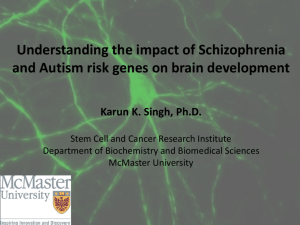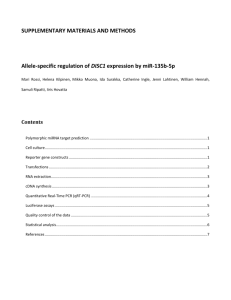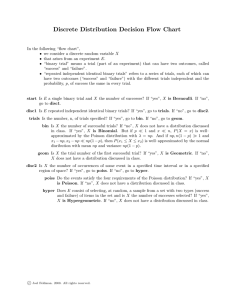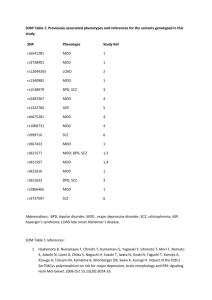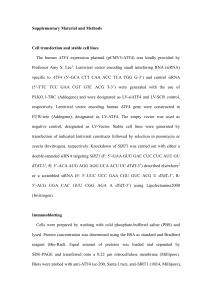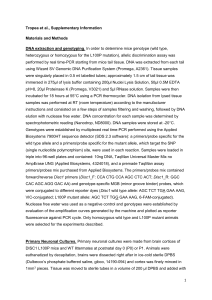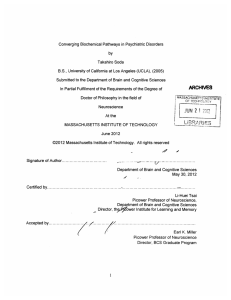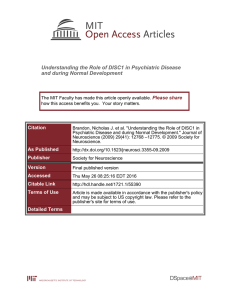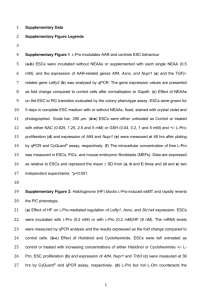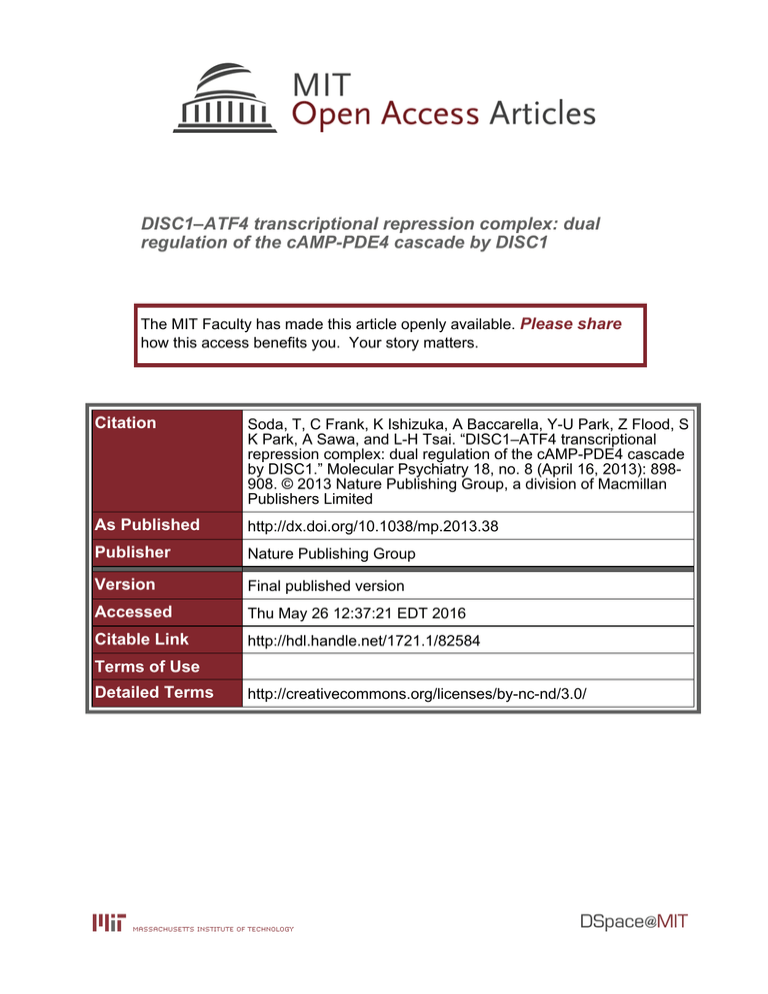
DISC1–ATF4 transcriptional repression complex: dual
regulation of the cAMP-PDE4 cascade by DISC1
The MIT Faculty has made this article openly available. Please share
how this access benefits you. Your story matters.
Citation
Soda, T, C Frank, K Ishizuka, A Baccarella, Y-U Park, Z Flood, S
K Park, A Sawa, and L-H Tsai. “DISC1–ATF4 transcriptional
repression complex: dual regulation of the cAMP-PDE4 cascade
by DISC1.” Molecular Psychiatry 18, no. 8 (April 16, 2013): 898908. © 2013 Nature Publishing Group, a division of Macmillan
Publishers Limited
As Published
http://dx.doi.org/10.1038/mp.2013.38
Publisher
Nature Publishing Group
Version
Final published version
Accessed
Thu May 26 12:37:21 EDT 2016
Citable Link
http://hdl.handle.net/1721.1/82584
Terms of Use
Detailed Terms
http://creativecommons.org/licenses/by-nc-nd/3.0/
OPEN
Molecular Psychiatry (2013) 18, 898–908
& 2013 Macmillan Publishers Limited All rights reserved 1359-4184/13
www.nature.com/mp
ORIGINAL ARTICLE
DISC1–ATF4 transcriptional repression complex: dual regulation
of the cAMP-PDE4 cascade by DISC1
T Soda1,2,3,4, C Frank1,2,3, K Ishizuka5, A Baccarella1, Y-U Park6, Z Flood1,2,3, SK Park6, A Sawa5 and L-H Tsai1,2,3
Disrupted-In-Schizophrenia 1 (DISC1), a risk factor for major mental illnesses, has been studied extensively in the context of
neurodevelopment. However, the role of DISC1 in neuronal signaling, particularly in conjunction with intracellular cascades that
occur in response to dopamine, a neurotransmitter implicated in numerous psychiatric disorders, remains elusive. Previous data
suggest that DISC1 interacts with numerous proteins that impact neuronal function, including activating transcription factor 4
(ATF4). In this study, we identify a novel DISC1 and ATF4 binding region in the genomic locus of phosphodiesterase 4D (PDE4D),
a gene implicated in psychiatric disorders. We found that the loss of function of either DISC1 or ATF4 increases PDE4D9
transcription, and that the association of DISC1 with the PDE4D9 locus requires ATF4. We also show that PDE4D9 is increased by
D1-type dopamine receptor dopaminergic stimulation. We demonstrate that the mechanism for this increase is due to DISC1
dissociation from the PDE4D locus in mouse brain. We further characterize the interaction of DISC1 with ATF4 to show that it is
regulated via protein kinase A-mediated phosphorylation of DISC1 serine-58. Our results suggest that the release of DISC1mediated transcriptional repression of PDE4D9 acts as feedback inhibition to regulate dopaminergic signaling. Furthermore, as
DISC1 loss-of-function leads to a specific increase in PDE4D9, PDE4D9 itself may represent an attractive target for therapeutic
approaches in psychiatric disorders.
Molecular Psychiatry (2013) 18, 898–908; doi:10.1038/mp.2013.38; published online 16 April 2013
Keywords: DISC1; ATF4; PDE4D; dopamine; PKA
INTRODUCTION
After the initial report on Disrupted-In-Schizophrenia 1 (DISC1) in a
large Scottish pedigree,1 the significance of this gene has been
extensively studied in human genetics and neurobiology.2,3
Although the involvement of this gene in any specific
psychiatric illness categorized by current diagnostic manuals
has been debated,4 DISC1 mediates many aspects of neurodevelopment and cellular signaling relevant to neuropsychiatric
disorders.
Studies utilizing various mouse models have implicated DISC1
as an important regulator of brain development with roles in
neurogenesis,5,6 progenitor proliferation5,7 and changes in
dendritic arborization, migration as well as the integration of
cortical and hippocampal neurons.8–13 These functions may be
mediated by protein–protein interactions between DISC1 and its
binding partners, which include NDEL1,14,15 GSK3b,5 BBS1/4,12,16
Girdin13,17 and Kalirin-7.18 Accordingly, animal models with
genetic manipulation of DISC1 display behavioral deficits,
including deficits in prepulse inhibition, latent inhibition, spatial
and working memory, sociability and increased immobile time in
the forced swim test.19 Furthermore, Niwa et al.20 reported that
transient deficits in neurodevelopment due to DISC1 deficits lead
to adult behavioral changes after adolescent brain maturation.
In addition to important roles of DISC1 in neurodevelopment,
DISC1 has a crucial function in neuronal signaling. Millar and
co-workers21–25 reported intriguing evidence that DISC1 binds
with several isoforms of a cyclic adenosine monophosphate
(cAMP)-specific, rolipram-sensitive family of phosphodiesterases,
referred to as phosphodiesterase 4D (PDE4s), and that it regulates
the enzymatic activity of these proteins via direct protein–protein
interaction. There are four PDE4 genes that constitute this family
of phosphodiesterases. Each of these four genes encodes an
isoform, and each isoform has a number of variants, each
distinguished by their unique N-terminal regions. These N-terminal regions confer unique functional roles to each PDE4 variant by
targeting interaction to specific protein complexes to influence
local cAMP levels in spatially constrained signaling processes.26,27
PDE4s break down cAMP, thereby terminating classical Gasprotein-coupled receptor signaling (GasSig), a well-studied
pathway downstream of the neurotransmitter dopamine, which
is heavily implicated in psychiatric disorders. Amphetamine
administration, which increases dopamine levels, is used as a
pharmacological model for schizophrenia in model animals. Firstgeneration antipsychotics are known to target the dopamine D2
receptor, which is known to antagonize GasSig. Mice with PDE4D
loss-of-function exhibit an antidepressive phenotype, that is,
decreased immobility time in the forced swim test28–30 and
increased neurogenesis,30 phenotypes opposite to those observed
in DISC1 mutant mice.31,32 PDE4 inhibition also enhances
dopaminergic signaling downstream of dopamine D1 receptor,33
which potentially explains the observation that DISC1 mutant
mice have an altered response to methamphetamine.34
1
Department of Brain and Cognitive Sciences, Picower Institute for Learning and Memory, Massachusetts Institute of Technology, Cambridge, MA, USA; 2Howard Hughes Medical
Institute, Cambridge, MA, USA; 3Stanley Center for Psychiatric Research, Broad Institute, Cambridge, MA, USA; 4Daniel Tosteson Medical Education Center, Boston, MA, USA;
5
Department of Psychiatry and Behavioral Sciences, Johns Hopkins University School of Medicine, Baltimore, MD, USA and 6Division of Molecular and Life Science, Department of
Life Science, Biotechnology Research Center, Pohang University of Science and Technology, Pohang, Korea. Correspondence: Dr L-H Tsai, Howard Hughes Medical Institute, 77
Massachusetts Avenue, Room 46-4235, Cambridge, MA 02139, USA.
E-mail: lhtsai@mit.edu
Received 20 August 2012; revised 12 January 2013; accepted 31 January 2013; published online 16 April 2013
DISC1 in neuronal signaling
T Soda et al
899
The involvement of DISC1 in gene transcription was initially
suggested by its association with activating transcription
factors 4 and 5 (ATF4 and ATF5), basic-region-leucine zipper
domain-containing transcription factors of the CREB/ATF
family.35 This finding has been substantiated by further
mechanistic studies showing that DISC1 represses ATF4mediated gene transcription.36,37 ATF4 (also known as CREB2)
regulates many biological processes, from hematopoiesis and
osteoblast differentiation to neuronal progenitor proliferation,
synaptic plasticity, learning and memory, and behavior.38 Of
particular interest is the regulation of ATF4 by dopamine
stimulation. Specifically, ATF4 levels increase in response to
dopaminergic stimulation.39 However, very little is known about
the effects of DISC1 dysfunction on the transcriptional targets of
ATF4 in the brain.
In this study, we investigated the role of ATF4 and DISC1 in
transcriptional repression and how this functional interaction
impacts dopaminergic signaling. We find that ATF4 and DISC1 act
together in a transcriptional repressor complex to regulate
specifically the transcription of PDE4D9, 1 of 11 known PDE4D
variants.40 PDE4D9 is a long variant of PDE4D that is
phosphorylated and regulated by protein kinase A (PKA) and
MAPKAPK2,40,41 for further details refer to Lynex et al.42 We
further demonstrate that this repressor activity is decreased
by dopamine via GasSig, which activates PKA and promotes
the phosphorylation of DISC1 at S58. Our findings illustrate that
the DISC1–ATF4 interaction regulates a transcriptional feedback
loop that responds to, and modulates, dopaminergic neurotransmission and provide mechanistic insights into how the perturbation of this complex may lead to aberrant signaling that may
manifest as symptomatology associated with various psychiatric
illnesses.
Production of pLentilox3.7 ATF4 shRNA
ATF4 and DISC1 short hairpin RNA (shRNA) were cloned into the pLentilox
3.7 vector (Addgene, Cambridge, MA, USA; plasmid 11795) as described
previously.5 Briefly, complementary 50 phosphorylated oligonucleotides
encoding anti-ATF4, DISC1 and PDE4D9 shRNA (sequences provided in
Supplementary Material Table 4) were annealed, digested with XhoI and
ligated into the pLentilox 3.7 vector that had been digested with HpaI and
XhoI. Proper insertion and orientation of the sequence downstream of the
U6 promoter was confirmed using the sequencing primer 50 -CAGTGCA
GGGGAAAGAATAGTAGAC-30 . To create DISC1 shRNA and scr-shRNA
mCherry, the GFP cDNA sequence contained within pLentilox3.7 was
excised and replaced with the mCherry cDNA sequence, obtained by
amplification using pCS2 þ -mCherry (Addgene; plasmid 31165).
Chromatin immunoprecipitation
Chromatin immunoprecipitations (ChIPs) were carried out from hippocampal or cortical tissue from adult (12-week-old) C57/B6J, or ATF4 þ / þ ,
ATF4 þ / and ATF4 / mice in a C57/B6J background, homogenized by
loose dounce, according to the manufacturer’s protocol for the EZMagnaChIP kit (Millipore, Temecula, CA, USA). A measure of 1 ml of eluted
purified DNA was used for each analysis condition.
Amphetamine treatment
Animals were injected intraperitoneally with 0.35 mg kg 1 D-amphetamine
sulfate (Tocris Bioscience, Bristol, UK) resuspended in 0.9% saline at
70 ng ml 1, or with saline, and then placed in a novel cage for 2 or 4 h for
observation.
Primary neuronal cultures
Dorsal hippocampal cultures were prepared from embryonic E15–16 SW
mice as described previously.47 Experiments were performed on 10–17
days in vitro (DIV) primary cultures. Dissociated rat cortical cultures were
prepared as described previously.18
Production and titration of virus
MATERIALS AND METHODS
Mice
C57/Bl6J (C57) mice were obtained from The Jackson Laboratory (Bar
Harbor, ME, USA). Pregnant Swiss-Webster (SW) mice were obtained from
Taconic (Hudson, NY, USA) after confirming that the colony did not contain
the 25 bp deletion within DISC1 found in some SW lines.43 ATF4 mice have
been described previously.44 All mice were kept in a reverse-light cycle and
food and water was provided ad libitum. All procedures were performed in
accordance with the CAC of MIT.
Generation of antibodies and plasmids
A table of antibodies and plasmids used in this study that have been
previously described is provided as Supplementary Material Tables 1 and 2.
Polyclonal antibodies were raised against a peptide identical to the
unique region of PDE4D9 (PDE4D9unq), amino-acid sequence
(MSIIMKPRSRSTSSLRTTEAVC) and the N-terminal 220 amino acids of DISC1
as described previously.44 Sera obtained (Covance, Princeton, NJ, USA)
were then subjected to affinity column purification to obtain purified
antibodies (Thermo Scientific Pierce, Rockford, IL, USA).
The 6-His-DISC1 N-terminal construct was generated by cloning the
N-terminal portion of mouse DISC1, amino acids 1–220, into the pET-32b þ
vector. Generation of GFP-mDISC1 and 3 FLAG-mDISC1 has been
described previously.5 Briefly, the full-length human DISC1 transcript was
isolated from cDNA, and then subcloned into the pEGFP-C1 vector
(Clontech, Takara, Mountain View, CA, USA). Glutathione S-transferase
(GST)-ATF4 has been described previously.44 Mutations of DISC1 were
introduced by polymerase chain reaction (PCR)-based mutagenesis.45
3 Myc PDE4D1, 2, 3, 4, 5, 6, 7, 8, 9, 10, and 11 cDNA were generated by
PCR amplification from a mouse brain cDNA library generated from wholebrain RNA extraction and cDNA synthesis, as described below, using 50
primers flanked by a Kozak (GCCACCATG) sequence and 30 primers flanked
by a XhoI restriction site. PDE4D primer sequences were adapted from
sequences used in a previous study46 to account for mouse sequences. The
3 MycPDE4D2-11 cDNAs were cloned into the EcoRV and XhoI sites of a
pcDNA(3.1) þ vector modified to add three Myc tags at the C-terminal end.
& 2013 Macmillan Publishers Limited
Lentiviral particles were made as described previously.5 Briefly, pMD.2G
and pCMVdeltaR8.2 (Addgene; plasmids 12259 and 12263) and
pLentilox3.7 constructs described previously were transfected into 90%
confluent HEK-293T cells at a ratio of 18:6:5 mg per 10 cm dish. The media
were replaced 4 h after transfection and they were collected 48 and 72 h
after transfection. Viral supernatant was filtered through a 0.45-mm cellular
acetate vacuum filter (Corning Incorporated, Corning, NY, USA; product
431155), and concentrated by ultracentrifugation at 25 000g for 90 min.
Viral pellets were resuspended in Dulbecco’s phosphate-buffered
saline þ 0.1% glucose and stored at 80 1C.
Viral titers were determined on HEK-293T cells plated at 2 105 cells per
well in six-well plates, and serial dilutions of 1:200, 1:2000 and 1:20 000
were used to determine viral titer. After 48 h of viral supernatant
application, percentage of infected cells were determined by determining
the percentage of fluorescent cells/total no. of cells by visual inspection.
Four fields of view were counted per well, and three wells were inspected
per dilution. Stereotactic injection into the dentate gyrus was performed
with viral titer 2 109 transducing units per ml.
mRNA isolation and analysis
RNA was isolated using the RNeasy plus mini kit (Qiagen, Valencia, CA,
USA). Briefly, the RLT plus buffer, supplemented with 10 ml ml 1 bmercaptoethanol, was added to cells or isolated brain tissue, and the lysate
was homogenized using a 28 G needle and syringe before proceeding
according to the manufacturer’s protocol. RNA integrity was evaluated by
spectroscopic analysis using the Nanodrop 2000 (Thermo Scientific).
cDNA synthesis, semiquantitative PCR and quantitative PCR
Equivalent amounts of RNA (0.8–1.2 mg) were used for cDNA synthesis
using First-strand cDNA synthesis kit (Invitrogen, Carlsbad, CA, USA)
according to the manufacturer’s instructions. Semiquantitative PCR was
conducted using the primers described at optimized annealing temperatures using the Quickload 2 PCR Mastermix (New England Biolabs,
Ipswich, MA, USA). Reactions were terminated at 25 cycles for glyceraldehyde 3-phosphate dehydrogenase, and multiple cycles were used for
Molecular Psychiatry (2013), 898 – 908
DISC1 in neuronal signaling
T Soda et al
900
other primers. The cycle with the biggest difference between conditions
was used for data analysis; this was typically between 25 and 32 cycles.
Quantitative PCR was conducted using the primers described at
optimized annealing temperatures. Briefly, 1 ml cDNA was used for each
reaction together with the SsoFast Evagreen Supermix (Bio-Rad, Hercules,
CA, USA) according to the manufacturer’s directions. The quantitative PCR
optical reaction was conducted in a T100 thermal cycler fitted with a CFX96
Touch real-time PCR system (Bio-Rad). All experiments were conducted
with triplicate samples for each cDNA sample per primer pair. All
experimental primer sets, as well as loading controls, were loaded onto
the same 96-well plate and normalization was conducted within each plate
before statistical analysis. Determination of relative PDE4D9 levels was
conducted using previously optimized primers.46,48,49
beads were washed four times with IP buffer, and then two times with PBS;
for the last wash, the beads were re-suspended in 5 ml PBS with protease
inhibitor, and 1.2 ml of the resuspended PBS beads was aliquoted into
each of four Eppendorf tubes. The PBS was removed from the GFP-agarose
beads and 50 ml of the GST-ATF4 in PKA kinase buffer (50 mM Tris-HCl,
10 mM MgCl2, 200 mM ATP (pH 7.5)) was added to each reaction condition.
In all, 2500 U of PKA, 2500 U of calf intestinal alkaline phosphatase or 0.5 mg
bovine serum albumin was added into the reaction mixture and allowed to
incubate at room temperature for 7 min before washing five times with IP
buffer. For the GFP-only input, the beads were washed following the
addition of bovine serum albumin in PKA kinase reaction buffer without
GST-ATF4. Input (2%) is shown for GST-ATF4.
Immunocytochemistry of primary neurons and HeLa cells
Luciferase activity assay
CAD or N2A cells were plated at a density of 2.5 105 cells per ml in 24well plates one day before transfection with a plasmid expressing Renilla
luciferase under the control of a human thymidine kinase 1 promoter (pRLTK; Promega, Madison, WI, USA), and Firefly luciferase within the pgl3
backbone under the control of numerous promoters and enhancers, as
described below, at a ratio of 1:10. For assays comparing ATF4 and DISC1
knockdown, cells were also transduced 2 h after transfection, with
lentivirus (multiplicity of infection ¼ 5) -expressing shRNA driven by a
mouse U6 promoter. Assays were conducted 2 days after transfection/viral
transduction using the dual-luciferase reporter assay kit (Promega) and
luminescence was detected using the Spectramax-L luminescence
microplate reader (Molecular Devices, Sunnyvale, CA, USA), and analyzed
as described previously.7
Immunoblot analysis
Unless otherwise indicated, at the end of the indicated treatments, cells
were lysed in RIPA buffer (50 mM Tris, pH 8.0, 150 mM NaCl, 1% NP40, 0.5%
sodium deoxycholate, 0.1% sodium dodecyl sulfate (SDS)) containing
protease and phosphatase inhibitors, and boiled after dilution in SDS
sample buffer (2% SDS, 0.6 M dithiothretiol, 62.5 mM Tris (pH 6.8), 10%
glycerol, 0.0025% bromophenol blue). Equal amounts of proteins were
subjected to SDS-polyacrylamide gel electrophoresis and western blot
analysis using the indicated antibodies at the concentrations included in
Supplementary Table 3. For protein extraction from whole tissue, the
forebrain or hippocampus was dissected and dounce homogenized in RIPA
buffer. Lysates were spun at 13 000 r.p.m. for 15 min, after which
supernatants were removed and analyzed for protein concentration
(Bio-Rad Protein Assay, Hercules, CA, USA). SDS buffer was added to equal
amounts of protein and immunoblot analysis was performed using 25–
200 mg of protein per well using the 1.5 mm gel thickness Mini-Protean
Tetra (Bio-Rad).
Co-immunoprecipitation
HEK293T or HeLa cells were transfected with various constructs using
Lipofectamine 2000 (Invitrogen). At 24 h after transfection, cells were lysed
with IP buffer (0.4% Triton X-100, 200 mM NaCl, 50 mM Tris 7.5), RIPA buffer
or hypotonic buffer (0.2% NP40, 5% glycerol, 0.5 mM MgCl2, 50 mM NaCl,
50 mM Tris 7.5) containing protease and phosphatase inhibitors. Equal
amounts of lysates were incubated with antibody-conjugated beads
(Sigma, Santa Cruz Biotechnology, Dallas, TX, USA) in IP buffer overnight at
4 1C, and then washed three times in IP buffer.
Immunoprecipitations were performed using equal amounts of protein
and by rocking the lysates with the 1 mg of the indicated antibodies in IP
buffer overnight at 4 1C, or by incubation with the indicated antibodies
overnight at 4 1C, followed by incubation with Protein A and Protein G
agarose beads for 1 h, and then washed three times in IP buffer, RIPA
buffer or hypotonic buffer before eluting in SDS buffer.
In vitro kinase-IP assay of GST-ATF4 and GFP-mDISC1
GST-ATF444 protein (0.5 mg) was re-suspended in 250 ml PKA kinase
reaction buffer (New England Biolabs) supplemented with 200 mM ATP.
HEK293T cells were transfected with GFP-mDISC1T15 and lysed 24 h after
transfection in IP buffer (0.4% Triton X-100, 200 mM NaCl, 50 mM Tris (pH
7.5)) with phosphatase and protease inhibitors. Following centrifugation to
remove cellular debris, GFP-DISC1mT1 was isolated by affinity purification
using 50 mg of mouse (B2) anti-GFP-agarose beads (Santa Cruz
Biotechnology, Santa Cruz, CA, USA) for 1 h at room temperature. The
Molecular Psychiatry (2013), 898 – 908
Immunolabeling of primary neurons and HeLa cells was performed as
described previously.12,36 When used, okadaic acid (0.5 mM; EMD Millipore,
Billerica, MA, USA) was added 2 h before cells were fixed. The percentage
of DISC1-positive cells was quantified by dividing the number of cells
showing nuclear DISC1 immunoreactivity by the number of 40 ,6-diamidino2-phenylindole-labeled cells.
Data analysis
All data were analyzed using the Prism software using statistical tests
indicated (GraphPad Software, La Jolla, CA, USA).
RESULTS
DISC1 binds to the PDE4D gene locus in an ATF4-dependent
manner
We identified an ATF4 binding site within the genomic locus
encoding the PDE4D gene in the course of an unbiased ChIP
screen that was conducted to identify ATF4 genomic target loci
in vivo in the developing brain (manuscript in preparation).
Binding to the locus on PDE4D, along with several other identified
loci, was confirmed by ChIP-PCR (Supplementary Figure 1). Given
that DISC1 regulates ATF4 transcriptional activity in vitro36 and
lacks a DNA-binding domain, we hypothesized that DISC1 associated with the PDE4D gene locus in an ATF4-dependent manner.
To test this hypothesis, we conducted ChIP-PCR using a
polyclonal DISC1 antibody that recognizes the N terminus of
DISC1 with dorsal hippocampal samples from 8-week-old wildtype (ATF4 þ / þ ), ATF4 heterozygous (ATF4 þ / ) and ATF4 knockout (ATF4 / ) littermate mice. We observed that the association
of DISC1 to the PDE4D locus was nearly absent in ATF4 / mice,
and severely disrupted in the ATF4 þ / littermates (Figure 1a).
These data indicate that the association of DISC1 to the PDE4D
locus requires the presence of ATF4.
Given that the PDE4D and DISC1 proteins have been shown to
interact directly,22,23,25 we felt that PDE4D was an interesting ATF4
target. Our ChIP data indicate that ATF4 binds to a region of the
PDE4D locus that is 50 to the common catalytic domain, and
downstream of some, but not all, of the unique PDE4D variant
exons.26,42 The location of the ATF4 and DISC1 binding site on the
PDE4D locus led us to hypothesize that ATF4 and DISC1 regulate
the transcription of some, but not all, PDE4D variants.
To characterize the regulation of the various PDE4D transcripts
by ATF4 and DISC1, we used shRNA to knock down these proteins
while measuring the mRNA levels of PDE4D variants using
semiquantitative PCR. DIV 14 cultured hippocampal neurons were
transduced at DIV 4 with lentivirus carrying control scrambled
(Scr), ATF4 or DISC1 shRNA-expressing lentivirus.5 Using
semiquantitative reverse transcription-PCR,48,50 an approach
used in the past to detect changes in differential expression of
the unique variants, we observed a marked increase specifically in
the levels of the PDE4D9 transcript upon both ATF4 and DISC1
shRNA-mediated knockdown (Figure 1b). This increase in PDE4D9
mRNA was confirmed with in situ hybridization in wild-type and
ATF4 / mice. Using an antisense probe targeting the unique N
terminus of PDE4D9 on E15 brain sections, we observed a
& 2013 Macmillan Publishers Limited
DISC1 in neuronal signaling
T Soda et al
901
Figure 1. Disrupted-In-Schizophrenia 1 (DISC1) binds to activating transcription factor 4 (ATF4) binding site within PDE4D region to regulate
PDE4D9 expression. (a) DISC1 binding to region within PDE4D gene is ATF4 dependent. DISC1 N-terminal antibody chromatin
immunoprecipitation (ChIP) was followed by amplification of purified DNA (n ¼ 3, one-way analysis of variance (ANOVA) Po0.05, *Dunnett’s
test Po0.05 relative to ATF4 þ / þ ). (b) Infection of dorsohippocampal neurons with lentivirus-expressing ATF4 or DISC1 short hairpin RNA
(shRNA) results in the specific increase of PDE4D9 transcripts. Semiquantitative reverse transcriptase-polymerase chain rection (sqRT-PCR) of
RNA obtained at days in vitro (DIV) 14 (n ¼ 4, one-sample ANOVA, *Po0.05). (c) In situ hybridization of E15 wild-type (WT) or ATF4 / with
antisense oligonucleotide to unique region of PDE4D9 demonstrates elevated levels of PDE4D9 in the absence of ATF4. (d) PDE4D9 protein
levels are elevated in 12-week-old ATF4 þ / mice compared with WT mice. (e) PDE4D9 protein levels are elevated in12-week-old C57/B6 mice
hippocampus injected with DISC1 shRNA compared with control (Ctrl) shRNA-injected mice. Immunoprecipitation followed by immunoblot
(IP-western) of hippocampal lysates (n ¼ 3, two-tailed t-test *Po0.05, woverloaded DISC-1 shRNA lane, disregard). A.U., arbitrary unit; GAPDH,
glyceraldehyde 3-phosphate dehydrogenase; IgG, immunoglobulin G; Scr, scrambled.
substantial increase in PDE4D9 transcripts in ATF4 / compared
with wild-type embryonic brains (Figure 1c).
Consistent with the observed increases in PDE4D9 mRNA,
PDE4D9 protein levels were also significantly increased in dorsal
hippocampal brain lysates from 8-week-old ATF4 þ / mice
compared with wild-type (ATF4 þ / þ ) littermates (Figure 1d). We
stereotactically injected lentivirus-expressing DISC1 shRNA into
the 8-week-old mouse hippocampus, and observed that PDE4D9
protein levels were significantly higher following this in vivo
shRNA-mediated DISC1 knockdown compared with control shRNA
(Figure 1e). Collectively, these results indicate that the loss of ATF4
or DISC1 expression specifically increases PDE4D9 mRNA. These
findings are consistent with the notion that ATF4 and DISC1
function in a transcriptional repressor complex at the PDE4D gene
locus to repress specifically transcription of the PDE4D9 isoform.
Collectively, these results suggest that ATF4 is necessary for the
recruitment of DISC1 to the PDE4D gene locus, and that these two
factors together regulate the expression of the PDE4D9 variant.
ATF4 and DISC1 bind the regulatory region of PDE4D9 and
suppress its transcription
PDE4 promoters do not have TATA boxes and other features that
help in its identification. To determine whether the increase in
PDE4D9 mRNA and protein that follows DISC1/ATF4 knockdown
& 2013 Macmillan Publishers Limited
results from increased transcriptional activity, we tested the
effects of ATF4 and DISC1 knockdown in luciferase-based reporter
assays using putative PDE4D promoter and enhancer regions, an
approach used successfully to identify promoter regions from
other PDE4 isoforms.51 We cloned the 1000 bp upstream of the
PDE4D9 coding region and placed this putative promoter region
upstream of the luciferase cDNA in the pGL3 vector (Figures 2a
and b). Compared with the baseline luciferase expression from
pGL3 alone, which lacks a promoter, we observed significant
luciferase activity in the presence of the 1000 bp fragment
(4D9pro-Luc; Figure 2b), suggesting that this region of the PDE4D
locus likely contains the PDE4D9 promoter. Next, we assayed
whether the presence of the ATF/DISC1 binding site of the PDE4D
locus affects the transcriptional activity of the putative PDE4D9
promoter. The ATF4/DISC1 binding site (B450 bp) was divided
into four fragments (EnhA–D), each of which was placed
immediately upstream of the putative PDE4D9 promoter. The
presence of fragments EnhA, EnhB and EnhC did not significantly
affect PDE4D9 promoter-driven luciferase activity. However,
fragment EnhD markedly increased the activity of the putative
PDE4D9 promoter (Figures 2a and b), marking it as a potential
enhancer region in the PDE4D9 locus.
Upon close examination of the sequence of EnhD, we identified
the sequence GGGTGCAAT, which has homology to known
non-palindromic ATF4:C/EBP binding motifs, consistent with our
Molecular Psychiatry (2013), 898 – 908
DISC1 in neuronal signaling
T Soda et al
902
Figure 2. The activating transcription factor 4–Disrupted-In-Schizophrenia 1 (ATF4–DISC1) binding region acts as a transcriptional repressor to
endogenous PDE4D9 promoter. (a) Schematic of PDE4D genetic loci. (b) Schematic of constructs used to study the transcriptional effects of
the ATF4–DISC1 binding region. (c) Placement of the 1000 bp region immediately upstream of PDE4D9 coding region in front of the luciferase
(Luc) gene upregulates luciferase activity, indicating that this region acts as a promoter. Fragment D significantly altered luciferase activity
relative to the others (n ¼ 5, analysis of variance (ANOVA) Po0.0001, *Dunnett’s test Po0.05 for comparison of Luc to all others, ***Tukey’s test
Po0.001 for EnhDPDE4D9 compared with other fragments, PDE4D9 promoter only). (d) A putative CRE/CEBP binding site was identified
within enhancer fragment D (EnhD). The site was mutated to eliminate sequence similarity to CRE/CEBP binding site. (e) Comparison of the
effects of control, ATF4 or DISC1 short hairpin RNA (shRNA) combinations on luciferase activity on EnhDPDE4D9. The presence of EnhD
upstream of the 4D9 promoter is critical for the dramatic elevation in signal seen after ATF4, DISC1 shRNA expression (n ¼ 5, ANOVA
Po0.0001, ***Tukey’s test Po0.001 for comparisons between EnhDPDE4D9 DISC1 shRNA and DISC1/ATF4 shRNA compared with all others).
NS, nonsignificant; Scr, scrambled.
findings that it may represent an ATF4 binding region
(Figure 2c).52–54 To test whether this sequence is responsible for
the transcription-enhancing ability of fragment EnhD, we repeated
the luciferase promoter assays using a mutated and wild-type
EnhD fragment in the presence of shRNA targeting ATF4, DISC1 or
both. The knockdown of ATF4 and DISC1 had no significant effect
Molecular Psychiatry (2013), 898 – 908
on the luciferase activity of the 4D9proLuc vector, which expresses
the putative PDE4D9 promoter alone, compared with control
shRNA. However, in the presence of the EnhD fragment in the
4D9proLuc vector, the knockdown of DISC1 led to an increase in
luciferase activity in transfected cells. This increase was also
observed in cells transfected with both ATF4 and DISC1 shRNA,
& 2013 Macmillan Publishers Limited
DISC1 in neuronal signaling
T Soda et al
903
but not in cells expressing shRNA against ATF4 alone. When the
putative ATF4 binding region was mutated in the EnhD fragment
(mutEnhD 4D9proLuc), none of the shRNAs significantly affected
the luciferase activity (Figure 2d), indicating a loss of enhancer-like
activity. Taken together, these results indicate that the ATF4/DISC1
binding site acts as an enhancer region to regulate PDE4D9
transcription, and that the binding of the DISC1 protein, via ATF4,
to this region acts to repress PDE4D9 promoter activity. The fact
that ATF4 knockdown alone does not significantly affect luciferase
expression suggests that the requirement for ATF4 binding may
not be captured in this construct. For example, in the genome,
ATF4 binding may serve the purpose of bringing the enhancer
region in close proximity with the promoter, a position that is recreated in our luciferase construct.
Signaling via the dopamine D1 receptor modulates the expression
of PDE4D9
As mentioned previously, PDE4s act to terminate Gas-proteincoupled receptor signaling (GasSig) downstream of dopamine D1
receptor activation, and the loss of PDE4D expression in mice has
an antidepressant effect,28 while overactivation of the D1 receptor
via amphetamine administration models aspects of schizophrenia
in animals.55 Thus, alterations in the levels of the PDE4D9 variant
may play an important role in neuronal dopaminergic signaling
pathways. To address whether the regulation of PDE4D9 by
ATF4/DISC1 is influenced by extracellular signaling, such as
neurotransmitters, we treated cultured hippocampal neurons
with potassium chloride (KCl, 55 mM), which induces generalized
depolarization, baclofen (100 mM), which activates the GABAB
receptor, or prostaglandin E2 (10mM), which binds the
prostaglandin E2 receptor and reportedly increases phosphodiesterase activity in other systems.56 Interestingly, none of
these agents influenced PDE4D9 levels in DIV 14 cultured
hippocampal neurons (Figure 3a and Supplementary Figure 3).
However, dopamine (100 mM) as well as isoproterenol (100 mM),
a b-adrenergic receptor agonist, significantly increased the level of
PDE4D9 mRNA (Figure 3a). We also observed an increase in
PDE4D1, 2 and 5, with dopamine and isoproterenol treatment,
consistent with past work demonstrating that elevated cAMP
levels increase these transcripts.57, 58 This suggests that agonists
of D1-type dopamine receptors, b-adrenergic receptors or GaScoupled, GPCR stimulation increase PDE4D9 transcription.
We then tested the effects of dopaminergic signaling on
PDE4D9 mRNA levels by using quantitative PCR in DIV 14 primary
hippocampal neurons treated with vehicle, dopamine (10 mM),
the D1-type receptor agonist SKF81297 (6-chloro-7,8-dihydroxy1-phenyl-2,3,4,5-tetrahydro-[1H]-3-benzazepine)
(3 mM)
and
the D2-type receptor agonist quinpirole (10 mM). We found that
treatment with dopamine and SKF81297, but not quinpirole,
increased PDE4D9 mRNA levels, indicating that activation
specifically of the dopamine D1-type receptor increases PDE4D9
transcription in neurons (Figure 3b). Furthermore, acute amphetamine treatment, which increases both noradrenergic and
dopaminergic signaling, at a dose shown to induce hyperactivity
(0.35 mg kg 1) in 8-week-old wild-type mice increased both
mRNA and protein levels of PDE4D9 in the hippocampus
(Figures 3c and d). Taken together, these results indicate
that PDE4D9 transcription is regulated by dopamine via D1-type
receptor signaling, and that neuropharmacologically relevant
doses of amphetamine increase PDE4D9 transcription in behaving
animals.
Dopamine and amphetamine regulate the association of DISC1
with the PDE4D9 enhancer region
To examine the role of DISC1 and ATF4 in the regulation of
PDE4D9 by D1-coupled signaling, we performed ChIP in hippocampal tissue from mice treated acutely either with amphetamine
& 2013 Macmillan Publishers Limited
(0.35 mg kg 1) or saline. DISC1 occupancy of the putative
PDE4D9 enhancer region was significantly lower at both 2 and
4 h following amphetamine administration compared with controls (Figure 4a). Interestingly, we also observed a detectable, but
nonsignificant, increase in ATF4 occupancy at this locus with
amphetamine treatment (Figure 4a). Taken together, these results
demonstrate that DISC1, but not ATF4, dissociates from the
PDE4D9 enhancer region upon dopaminergic stimulation of D1type receptors, thereby de-repressing PDE4D9 transcription in an
activity-dependent manner.
PKA phosphorylation impairs the interaction of DISC1 and ATF4
ATF4 and DISC1 have both been shown to be phosphorylated by
PKA.12,59 Following phosphorylation by PKA, ATF4 switches from
being a repressor to being an activator.59 Given the importance of
PKA in regulating both ATF4 and DISC1 function, we examined
whether PKA phosphorylation affects the DISC1–ATF4 interaction.
To this end, full-length GFP-tagged DISC1 and GST-tagged ATF4
proteins were purified and subjected to an in vitro binding assay.
We found that the interaction of DISC1 with ATF4 was
substantially diminished in the presence of the catalytic domain
of PKA compared with non-transfected controls, and that the
addition of alkaline phosphatase increased the DISC1–ATF4
interaction (Figure 4b). Thus, PKA-mediated phosphorylation of
DISC1, ATF4 or both disrupts their interaction.
We then sought to determine how the PKA-mediated
phosphorylation of DISC1 impacts its function as a transcriptional
repressor. When primary rat neurons were treated with forskolin, a
potent PKA activator, the abundance of nuclear DISC1 decreased
dramatically compared with the DMSO control (Figure 4c). Taken
together, these results demonstrate that PKA activation leads
to a change in affinity between DISC1 and ATF4, leading to
changes in DISC1 localization and occupancy of DISC1 at the
PDE4D enhancer region.
The phosphorylation of DISC1 S58 mediates ATF4–DISC1
interaction and DISC1 nuclear localization
Previous work has shown that serine-58 (58S) of DISC1 is
phosphorylated by PKA12 and that this residue is proximal to a
nuclear localization signal.36 Thus, we tested whether the PKAmediated phosphorylation of this residue is responsible for the
altered subcellular distribution of DISC1 following PKA activation.
HeLa cells were transfected with vectors expressing wild-type or
an S58A mutant of DISC1, and treated with okadaic acid, another
PKA enhancer. We observed that PKA activation reduced the
nuclear distribution of wild-type DISC1, and that this effect was
significantly smaller for the S58A mutant, indicating that
phosphorylation at this site affects the subcellular distribution of
DISC1 (Figure 5a). Indeed, the basal localization of the S58A DISC1
mutant was primarily nuclear, whereas the phosphomimetic
mutant, S58E, appeared mainly in the cytosol (Figure 5b). In
addition, phosphorylation of S58 appears to regulate the
interaction between DISC1 and ATF4, which increases in the
presence of S58A, and decreases with S58E, compared with wildtype DISC1 (Figure 5c).
PDE4D9 is a cytosolic protein that colocalizes with, and binds to,
DISC1 but not ATF4
Previous studies have demonstrated that DISC1 binds to, and
affects, the activity of several PDE4D isoforms.25 These interactions
are also regulated by PKA and raises the possibility that PDE4D9
itself may form a complex with DISC1 and ATF4. To address
whether this is the case, we conducted immunoprecipitation
studies between PDE4D9, DISC1 and ATF4. PDE4D9 interacts with
DISC1, and this interaction decreases with dopamine treatment;
conversely, we did not observe any interaction between PDE4D9
and ATF4 (Supplementary Figure 4). To address the subcellular
Molecular Psychiatry (2013), 898 – 908
DISC1 in neuronal signaling
T Soda et al
904
Figure 3. Gs-coupled G-protein coupled receptor signaling leads to increases in PDE4D9 levels. (a) Dopamine (DA) and isoproterenol (Iso) (badrenergic receptor agonist), but not KCl (general activator of neuronal activity via depolarization), semiquantitative reverse transcriptasepolymerase chain rection (sqRTPCR) of PDE4D9 from RNA treated with vehicle (Veh) or compound at 2 and 4 h (n ¼ 4–6, analysis of variance
(ANOVA) Po0.05, *Tukey’s test Po0.05 compared with vehicle treatment). (b) Dopamine and isoproterenol treatment lead to increases in
PDE4D1, 2, 5 and 9 but not PDE4D3, 4, 6 and 7 (n ¼ 4–6 ANOVA Po0.05, *Tukey’s test Po0.05 compared with vehicle treatment). (c) D1-type,
but not D2-type dopamine receptor agonists, lead to detectable changes in PDE4D9 transcript. Dopamine (10 mM) and SKF81297 (6-chloro-7,8dihydroxy-1-phenyl-2,3,4,5-tetrahydro-[1H]-3-benzazepine) (3 mM), but not quinpirole (10 mM) treatment, lead to detectable increases in PDE4D9
levels, assayed by quantitative PCR (qPCR) for unique region of PDE4D9 (n ¼ 3, ANOVA Po0.05, *Po0.05 Dunnett’s test). (d) 0.35 mg kg 1
amphetamine treatment of C57Bl6/J mice leads to detectable increases in PDE4D9 transcript by sqRTPCR (n ¼ 4, *Student’s t-test Po0.05).
(e) In all, 0.35 mg kg 1 amphetamine treatment leads to detectable increases in PDE4D9 protein levels by immunoprecipitation (IP)-western
using PDE4D9 antibody (n ¼ 3, ANOVA Po0.05, *Tukey’s test Po0.05 for comparison to vehicle levels). A.u., arbitrary unit; GAPDH,
glyceraldehyde 3-phosphate dehydrogenase; NS, nonsignificant.
localization of PDE4D9 in relation, C-terminal-myc-tagged PDE4D9
was overexpressed in DIV 10 hippocampal neurons. PDE4D9 is
cytosolic, whereas ATF4 is nuclear. DISC1 expression is seen in
both the nucleus and the cytoplasm. No gross changes were seen
in localization of PDE4D9 with dopamine treatment
(Supplementary Figure 4).
DISCUSSION
Since its discovery more than a decade ago, extensive study has
revealed multiple roles for DISC1 in neurodevelopment. Many of
these roles are implicated in etiologies of neuropsychiatric
disorders of neurodevelopmental origin, including neurogenesis,
neuronal migration and integration.3,8,12,13,15,17,18 In contrast,
the main finding of this study was the elucidation of a novel
role for DISC1 in intracellular signaling involving dopaminergic
neurotransmission. This newly described function of DISC1 may
underlie important pathophysiologies of various neuropsychiatric
disorders. Given that molecules involved in these physiologies
may represent attractive targets for drug discovery, our
findings have significance in the translational aspects of clinical
medicine. Furthermore, through this study, we also delineate a
novel mechanism involving the regulation of PDE4 at two levels,
Molecular Psychiatry (2013), 898 – 908
that is, at the protein level (interaction with DISC1, shown
previously22,25) and at the transcriptional level (mediated by
DISC1–ATF4, this study).
DISC1 associates with the genomic locus and represses the
transcription of an ATF4 transcriptional target
The ATF4 transcription factor contains a basic-leucine-zipper
domain and can homodimerize or form heterodimers with many
interaction partners including those from the AP-1 and C/EBP
family. The ATF4 homo- or heterodimers have different affinities
for various DNA binding regions. Previous studies have demonstrated that ATF4 binding of DISC1 is dependent on a leucinezipper domain contained within DISC1.36 In this paper, we show
that the interaction of DISC1 with the PDE4D locus is dependent
on ATF4; this is consistent with the notion that DISC1 forms a
heterodimer with ATF4 to bind to this genomic region, and
furthermore that the ATF4/DISC1 heterodimer is repressive to
transcription. The role of DISC1’s interactions with other
transcriptionally relevant partners is not well-characterized, and
further studies in this area would add to our understanding of
DISC1 function in transcriptional regulation by providing clues as
to the composition of the ATF4–DISC1 repressor complex,
potentially identifying novel targets for therapeutic intervention.
& 2013 Macmillan Publishers Limited
DISC1 in neuronal signaling
T Soda et al
905
Figure 4. Gs-coupled and downstream effects lead to dissociation of Disrupted-In-Schizophrenia 1 (DISC1) from activating transcription factor
4 (ATF4). (a) Chromatin immunoprecipitation (ChIP) using DISC1 and ATF4 antibodies after amphetamine treatment (0.35 mg kg 1) from C57/
Bl6J hippocampus reveals that there is loss of DISC1 occupancy at the PDE4D9 locus compared with vehicle (Veh)-injected mice. Quantification
of DISC1 occupancy at PDE4D9 locus (n ¼ 6, analysis of variance (ANOVA) Po0.05, Dunnett’s test Po0.001 for comparisons between vehicle
injection and 2 and 4 h after amphetamine injection). Quantification of ATF4 occupancy at the PDE4D9 locus (n ¼ 6, ANOVA P ¼ 0.13). (b)
Purified glutathione S-transferase (GST)-tagged ATF4 protein and GFP-DISC1 protein, from overexpression in bacteria and HEK293T cells,
respectively, decrease interaction in vitro after the addition of the catalytic unit of protein kinase A (PKA). Quantification of (b) (n ¼ 4, ANOVA
Po0.05, *Po0.05, **Po0.01 by Newman–Keuls post hoc analysis). (c) Forskolin treatment (100 mM, overnight) decreases nuclear distribution of
DISC1 in rat cortical primary neurons. Red, DISC1; blue, 40 ,6-diamidino-2-phenylindole (DAPI) (nucleus). A.u., arbitrary unit; BSA, bovine serum
albumin; CIP, calf intestinal alkaline phosphatase; DMSO, dimethylsulfoxide; IgG, immunoglobulin G.
Dual regulation of PDE4
PDE4s suppress and terminate cAMP signaling in various distinct
subcellular compartments by converting cAMP to AMP. Our
finding that cAMP signaling alters the interaction profile of ATF4
and DISC1, thereby increasing PDE4D9 expression, adds to the
growing body of literature on the regulation of PDE4s by DISC1.
Previous studies have shown that DISC1 regulates some, but not
all, gene products of the four PDE4 genes via direct interaction
and inhibition in a cAMP activity-dependent manner.22,23 Both
mechanisms, that is, direct inhibition of activity and transcriptional
repression of phosphodiesterases, are regulated by PKA,
indicating that these two mechanisms are activated in a
feedback mechanism to regulate cAMP signaling in different
timeframes, and in specific subcellular regions. The dissociation of
PDE4s from DISC1 in response to cAMP signaling reflects an acute
feedback, in which increased cAMP signaling induces its own
termination signal by releasing PDE4s from sequestration by
DISC1. On the other hand, transcriptional induction reflects a
longer-term, sustained feedback mechanism, in which increased
cAMP signaling increases PDE4D9 levels, leaving the cell
poised to shut down cAMP activity. This finding may have
therapeutic implications. Further studies exploring the role of
PDE4D9 in, for example, amphetamine-induced sleep
disturbances, sensitization and withdrawal may be warranted.
The recent discovery of differences in DISC1–ATF4 interaction by
human DISC1 coding variants37 also indicates that there
may be human coding variants of DISC1 that are likely to elicit
differential responses to dopaminergic stimulation at the cellular
& 2013 Macmillan Publishers Limited
level, in addition to having baseline differences in DISC1–ATF4
interaction, which may help to explain the observed differences in
attention observed in DISC1 coding variants,60 as norepinephrine
and dopamine61,62 are implicated in the coupling of attentionrelated networks.
The DISC1–ATF4 interaction is physiologically regulated
Dopaminergic signaling, via the D1 receptor, as well as
noradrenergic signaling, via the b1 and b2 receptors, activate
Gas, leading to the activation of adenylyl cyclase and increased
cAMP levels. High concentration of cAMP activates PKA, and the
PDE4s terminate this signaling in different subcellular locations by
converting cAMP to AMP.48 Numerous psychotherapeutic agents
impact cAMP levels via secondary actions. The classical
antidepressants, monoamine oxidase inhibitors, act by elevating
dopamine, serotonin and norepinephrine, while cocaine and
amphetamines, abused for their euphoric effects and noted for
psychotomimetic actions, act through the excitation of
dopaminergic signaling. ATF4-dependent transcription is
mediated by several factors, including oxidative/nutrient stress
and cAMP-induced PKA activity. Notably, the cocaineamphetamine response transcript, which is a product of ATF4mediated transcription, is upregulated in response to cocaine and
amphetamine treatment.59 Our study provides further clues into
the pathophysiology of psychiatric phenotypes secondary to the
dysregulation of this pathway. An increase in PDE4D9 levels
secondary to the activation of cAMP is a form of transcriptional
Molecular Psychiatry (2013), 898 – 908
DISC1 in neuronal signaling
T Soda et al
906
disorders. Perturbing levels of PDE4D9, with its unique N-terminal
domain, and presumably unique interaction partners, would be
predicted to have an outcome that is more specific than that of
inhibiting all PDE4 variants, as is the case with rolipram. Indeed,
rolipram has an undesirable side-effect profile.28,30 Despite the
limited studies on PDE4D9, there is evidence for its involvement in
G-protein-coupled receptor signaling.64 Further studies characterizing the subcellular localization and effect of increasing and
decreasing the expression of this specific variant may reveal
PDE4D9 as a viable and worthwhile therapeutic target, or reveal
novel insights about subcompartments of cAMP signaling
important for psychiatric disorder pathophysiology. The perturbation of this pathway may disrupt the ability of neurons to
respond appropriately to neurotransmitter signaling, ultimately
affecting the neuronal circuitry and resulting in abnormal
behavioral responses that may manifest as psychiatric disease.
CONFLICT OF INTEREST
The authors declare no conflict of interest.
ACKNOWLEDGEMENTS
Figure 5. Phosphorylation of Disrupted-In-Schizophrenia 1 (DISC1)
at serine-58 (58S) regulates its subcellular distribution and interaction with activating transcription factor 4 (ATF4). (a) HeLa cells were
transfected with wild–type (WT) or phospho dead mutant A58DISC1. Treatment with okadaic acid, an enhancer of protein kinase A
(PKA), induced significant reduction in nuclear distribution of WT
DISC1. This reduction was diminished for A58-DISC1. Data are
representative of three independent experiments, analysis of
variance (ANOVA) Po0.05, *Po0.05 by conferring post hoc analysis.
(b) Phospho dead mutant A58- and phospho mimic mutant E58DISC1 showed particular DISC1 intracellular distribution patterns:
A58-DISC1, nuclear dominant pattern; E58-DISC1, cytosolic dominant pattern. Green, DISC1; blue, 40 ,6-diamidino-2-phenylindole
(DAPI) (nucleus). (c) Increased binding of ATF4 with A58-DISC1
compared with E58-DISC1 in HeLa cells by co-immunoprecipitation
(IP). Data are representative of six independent experiments, ANOVA
Po0.05, *Po0.05, ***Po0.001 by Bonferroni post hoc analysis. A.U.,
arbitrary unit; IB, immunoblotting.
feedback regulation necessary for the proper maintenance of
baseline cAMP levels and activity (Supplementary Figure 5). With
DISC1 loss-of-function, cells have higher baseline levels of
PDE4D9. This baseline increase in a phosphodiesterase would
perturb Gasig propagation downstream of dopamine D1 receptors
(Supplementary Figure 5). This form of regulation is mechanistically distinct from the cAMP-mediated regulation of other
PDE4D variants, namely PDE4D1 and 2, which have been shown to
be regulated by CREB.57 Thus, this study adds to the literature
demonstrating the intricate nature of PDE4D regulation.
Previous findings that PDE4D levels are regulated by both
chronic antidepressants and rolipram administration further
implicate the cAMP pathway in the regulation of PDE4D
transcription.63 Our study provides a biochemical basis for this
regulation, by demonstrating that the phosphorylation of DISC1
serine 58 results in a decreased interaction of DISC1 with ATF4 and
a resulting change in DISC1 localization to a more extranuclear
position.
Our results may also offer interesting insights on therapeutic
approaches that target PDE4s in the treatment of psychiatric
Molecular Psychiatry (2013), 898 – 908
We thank Drs A Bero, F Calderon, M Conti, EJ Kwon, M Lewis, A Mungenast,
W Richter and SC Su for critical reading of the manuscript and suggestions.
We also acknowledge E Berry, K Dennehy and M Eichler for technical assistance
throughout. TS was supported by award Number T32GM07753 from the National
Institute of General Medical Sciences and is a Henry E Singleton (1940) Fellow. This
work was, in part, supported by Brain Research Center of the 21st Century
Frontier Research Program Grant 2012K001115 (to SKP), 2012R1A2A2A01012923 (to
SKP) and 2011-0023973 (to YUP), funded by the MEST, Republic of Korea.
This work was supported by NIH R01 MH091115 (L-HT), MH-094268 Silvo O Conte
center (AS), MH-069853 (AS), NIH MH096208 (KI) and MSCRFE-0081-00(KI).
L-HT is a Howard Hughes Medical Institute investigator. The content is solely the
responsibility of the authors and does not necessarily represent the official
views of the National Institute of General Medical Sciences or the National Institutes
of Health.
REFERENCES
1 Millar JK, Wilson-Annan JC, Anderson S, Christie S, Taylor MS, Semple CA et al.
Disruption of two novel genes by a translocation co-segregating with schizophrenia. Hum Mol Genet 2000; 9: 1415–1423.
2 Porteous DJ, Millar JK, Brandon NJ, Sawa A. DISC1 at 10: connecting psychiatric
genetics and neuroscience. Trends Mol Med 2011; 17: 699–706.
3 Brandon NJ, Sawa A. Linking neurodevelopmental and synaptic theories of
mental illness through DISC1. Nat Rev Neurosci 2011; 12: 707–722.
4 Kim Y, Zerwas S, Trace SE, Sullivan PF. Schizophrenia genetics: where next?
Schizophrenia Bull 2011; 37: 456–463.
5 Mao Y, Ge X, Frank CL, Madison JM, Koehler AN, Doud MK et al. Disrupted in
schizophrenia 1 regulates neuronal progenitor proliferation via modulation of
GSK3beta/beta-catenin signaling. Cell 2009; 136: 1017–1031.
6 Kim JY, Liu CY, Zhang F, Duan X, Wen Z, Song J et al. Interplay between DISC1 and
GABA signaling regulates neurogenesis in mice and risk for schizophrenia. Cell
2012; 148: 1051–1064.
7 Singh KK, Ge X, Mao Y, Drane L, Meletis K, Samuels BA et al. Dixdc1 is a
critical regulator of DISC1 and embryonic cortical development. Neuron 2010; 67:
33–48.
8 Duan X, Chang JH, Ge S, Faulkner RL, Kim JY, Kitabatake Y et al. Disrupted-inschizophrenia 1 regulates integration of newly generated neurons in the adult
brain. Cell 2007; 130: 1146–1158.
9 Faulkner RL, Jang MH, Liu XB, Duan X, Sailor KA, Kim JY et al. Development of
hippocampal mossy fiber synaptic outputs by new neurons in the adult brain.
Proc Natl Acad Sci USA 2008; 105: 14157–14162.
10 Taya S, Shinoda T, Tsuboi D, Asaki J, Nagai K, Hikita T et al. DISC1 regulates the
transport of the NUDEL/LIS1/14-3-3epsilon complex through kinesin-1. J Neurosci
2007; 27: 15–26.
11 Namba T, Ming GL, Song H, Waga C, Enomoto A, Kaibuchi K et al. NMDA receptor
regulates migration of newly generated neurons in the adult hippocampus via
disrupted-in-schizophrenia 1 (DISC1). J Neurochem 2011; 118: 34–44.
& 2013 Macmillan Publishers Limited
DISC1 in neuronal signaling
T Soda et al
907
12 Ishizuka K, Kamiya A, Oh EC, Kanki H, Seshadri S, Robinson JF et al. DISC1dependent switch from progenitor proliferation to migration in the developing
cortex. Nature 2011; 473: 92–96.
13 Kim JY, Duan X, Liu CY, Jang MH, Guo JU, Pow-anpongkul N et al. DISC1 regulates
new neuron development in the adult brain via modulation of AKT-mTOR
signaling through KIAA1212. Neuron 2009; 63: 761–773.
14 Kamiya A, Tomoda T, Chang J, Takaki M, Zhan C, Morita M et al. DISC1-NDEL1/
NUDEL protein interaction, an essential component for neurite outgrowth, is
modulated by genetic variations of DISC1. Hum Mol Genet 2006; 15:
3313–3323.
15 Kamiya A, Kubo K, Tomoda T, Takaki M, Youn R, Ozeki Y et al. A schizophreniaassociated mutation of DISC1 perturbs cerebral cortex development. Nat Cell Biol
2005; 7: 1167–1178.
16 Kamiya A, Tan PL, Kubo K, Engelhard C, Ishizuka K, Kubo A et al.
Recruitment of PCM1 to the centrosome by the cooperative action of DISC1
and BBS4: a candidate for psychiatric illnesses. Arch Gen Psychiatry 2008; 65:
996–1006.
17 Enomoto A, Asai N, Namba T, Wang Y, Kato T, Tanaka M et al. Roles of disruptedin-schizophrenia 1-interacting protein girdin in postnatal development of the
dentate gyrus. Neuron 2009; 63: 774–787.
18 Hayashi-Takagi A, Takaki M, Graziane N, Seshadri S, Murdoch H, Dunlop AJ et al.
Disrupted-in-schizophrenia 1 (DISC1) regulates spines of the glutamate synapse
via Rac1. Nat Neurosci 2010; 13: 327–332.
19 Jaaro-Peled H. Gene models of schizophrenia: DISC1 mouse models. Progr Brain
Res 2009; 179: 75–86.
20 Niwa M, Kamiya A, Murai R, Kubo K, Gruber AJ, Tomita K et al. Knockdown of
DISC1 by in utero gene transfer disturbs postnatal dopaminergic maturation in
the frontal cortex and leads to adult behavioral deficits. Neuron 2010; 65:
480–489.
21 Millar JK, Mackie S, Clapcote SJ, Murdoch H, Pickard BS, Christie S et al. Disrupted
in schizophrenia 1 and phosphodiesterase 4B: towards an understanding of
psychiatric illness. J Physiol 2007; 584(Part 2): 401–405.
22 Millar JK, Pickard BS, Mackie S, James R, Christie S, Buchanan SR et al. DISC1 and
PDE4B are interacting genetic factors in schizophrenia that regulate cAMP
signaling. Science 2005; 310: 1187–1191.
23 Bradshaw NJ, Soares DC, Carlyle BC, Ogawa F, Davidson-Smith H, Christie S et al.
PKA phosphorylation of NDE1 is DISC1/PDE4 dependent and modulates its
interaction with LIS1 and NDEL1. J Neurosci 2011; 31: 9043–9054.
24 Carlyle BC, Mackie S, Christie S, Millar JK, Porteous DJ. Co-ordinated action of
DISC1, PDE4B and GSK3beta in modulation of cAMP signalling. Mol Psychiatry
2011; 16: 693–694.
25 Murdoch H, Mackie S, Collins DM, Hill EV, Bolger GB, Klussmann E et al.
Isoform-selective susceptibility of DISC1/phosphodiesterase-4 complexes
to dissociation by elevated intracellular cAMP levels. J Neurosci 2007; 27:
9513–9524.
26 Houslay MD, Baillie GS, Maurice DH. cAMP-specific phosphodiesterase-4
enzymes in the cardiovascular system: a molecular toolbox for generating compartmentalized cAMP signaling. Circ Res 2007; 100: 950–966.
27 Houslay MD. Underpinning compartmentalised cAMP signalling through targeted
cAMP breakdown. Trends Biochem Sci 2010; 35: 91–100.
28 Zhang HT, Huang Y, Jin SL, Frith SA, Suvarna N, Conti M et al. Antidepressant-like
profile and reduced sensitivity to rolipram in mice deficient in the
PDE4D phosphodiesterase enzyme. Neuropsychopharmacology 2002; 27:
587–595.
29 Schaefer TL, Braun AA, Amos-Kroohs RM, Williams MT, Ostertag E, Vorhees CV. A
new model of Pde4d deficiency: genetic knock-down of PDE4D enzyme in rats
produces an antidepressant phenotype without cognitive effects. Genes Brain
Behav 2012; 11: 614–622.
30 Li YF, Cheng YF, Huang Y, Conti M, Wilson SP, O’Donnell JM et al. Phosphodiesterase-4D knock-out and RNA interference-mediated knock-down enhance
memory and increase hippocampal neurogenesis via increased cAMP signaling.
J Neurosci 2011; 31: 172–183.
31 Lipina TV, Wang M, Liu F, Roder JC. Synergistic interactions between PDE4B and
GSK-3: DISC1 mutant mice. Neuropharmacology 2012; 62: 1252–1262.
32 Pletnikov MV, Ayhan Y, Nikolskaia O, Xu Y, Ovanesov MV, Huang H et al. Inducible
expression of mutant human DISC1 in mice is associated with brain and
behavioral abnormalities reminiscent of schizophrenia. Mol Psychiatry 2008; 13:
173–186115.
33 Kuroiwa M, Snyder GL, Shuto T, Fukuda A, Yanagawa Y, Benavides DR et al.
Phosphodiesterase 4 inhibition enhances the dopamine D1 receptor/PKA/DARPP32 signaling cascade in frontal cortex. Psychopharmacology 2012; 219:
1065–1079.
34 Pogorelov VM, Nomura J, Kim J, Kannan G, Ayhan Y, Yang C et al. Mutant
DISC1 affects methamphetamine-induced sensitization and conditioned place
preference: a comorbidity model. Neuropharmacology 2012; 62: 1242–1251.
& 2013 Macmillan Publishers Limited
35 Morris JA, Kandpal G, Ma L, Austin CP. DISC1 (Disrupted-In-Schizophrenia 1) is a
centrosome-associated protein that interacts with MAP1A, MIPT3, ATF4/5 and
NUDEL: regulation and loss of interaction with mutation. Hum Mol Genet 2003; 12:
1591–1608.
36 Sawamura N, Ando T, Maruyama Y, Fujimuro M, Mochizuki H, Honjo K et al.
Nuclear DISC1 regulates CRE-mediated gene transcription and sleep homeostasis
in the fruit fly. Mol Psychiatry 2008; 13: 1138–11481069.
37 Malavasi EL, Ogawa F, Porteous DJ, Millar JK. DISC1 variants 37W and 607F disrupt
its nuclear targeting and regulatory role in ATF4-mediated transcription. Hum Mol
Genet 2012; 21: 2779–2792.
38 Ameri K, Harris AL. Activating transcription factor 4. Int J Biochem Cell Biol 2008;
40: 14–21.
39 Green TA, Alibhai IN, Unterberg S, Neve RL, Ghose S, Tamminga CA et al. Induction
of activating transcription factors (ATFs) ATF2, ATF3, and ATF4 in the nucleus
accumbens and their regulation of emotional behavior. J Neurosci 2008; 28:
2025–2032.
40 Gretarsdottir S, Thorleifsson G, Reynisdottir ST, Manolescu A, Jonsdottir S,
Jonsdottir T et al. The gene encoding phosphodiesterase 4D confers risk of
ischemic stroke. Nat Genet 2003; 35: 131–138.
41 MacKenzie KF, Wallace DA, Hill EV, Anthony DF, Henderson DJ, Houslay DM et al.
Phosphorylation of cAMP-specific PDE4A5 (phosphodiesterase-4A5) by MK2
(MAPKAPK2) attenuates its activation through protein kinase A phosphorylation.
Biochem J 2011; 435: 755–769.
42 Lynex CN, Li Z, Chen ML, Toh KY, Low RW, Goh DL et al. Identification and
molecular characterization of a novel PDE4D11 cAMP-specific phosphodiesterase
isoform. Cell Signal 2008; 20: 2247–2255.
43 Koike H, Arguello PA, Kvajo M, Karayiorgou M, Gogos JA. Disc1 is mutated in the
129S6/SvEv strain and modulates working memory in mice. Proc Natl Acad Sci USA
2006; 103: 3693–3697.
44 Frank CL, Ge X, Xie Z, Zhou Y, Tsai LH. Control of activating transcription factor 4
(ATF4) persistence by multisite phosphorylation impacts cell cycle progression
and neurogenesis. J Biol Chem 2010; 285: 33324–33337.
45 Ho SN, Hunt HD, Horton RM, Pullen JK, Pease LR. Site-directed mutagenesis
by overlap extension using the polymerase chain reaction. Gene 1989; 77:
51–59.
46 Richter W, Jin SL, Conti M. Splice variants of the cyclic nucleotide phosphodiesterase PDE4D are differentially expressed and regulated in rat tissue. Biochem
J 2005; 388(Pt 3): 803–811.
47 Giusti-Rodriguez P, Gao J, Graff J, Rei D, Soda T, Tsai LH. Synaptic deficits
are rescued in the p25/Cdk5 model of neurodegeneration by the reduction of
beta-secretase (BACE1). J Neurosci 2011; 31: 15751–15756.
48 Jin SL, Bushnik T, Lan L, Conti M. Subcellular localization of rolipram-sensitive,
cAMP-specific phosphodiesterases. Differential targeting and activation
of the splicing variants derived from the PDE4D gene. J Biol Chem 1998; 273:
19672–19678.
49 Nemoz G, Zhang R, Sette C, Conti M. Identification of cyclic AMP-phosphodiesterase variants from the PDE4D gene expressed in human peripheral mononuclear cells. FEBS Lett 1996; 384: 97–102.
50 Barber R, Baillie GS, Bergmann R, Shepherd MC, Sepper R, Houslay MD et al.
Differential expression of PDE4 cAMP phosphodiesterase isoforms in inflammatory cells of smokers with COPD, smokers without COPD, and nonsmokers.
Am J Physiol Lung Cell Mol Physiol 2004; 287: L332–L343.
51 Wallace DA, Johnston LA, Huston E, MacMaster D, Houslay TM, Cheung YF et al.
Identification and characterization of PDE4A11, a novel, widely expressed long
isoform encoded by the human PDE4A cAMP phosphodiesterase gene. Mol
Pharmacol 2005; 67: 1920–1934.
52 Siu F, Bain PJ, LeBlanc-Chaffin R, Chen H, Kilberg MS. ATF4 is a mediator of the
nutrient-sensing response pathway that activates the human asparagine synthetase gene. J Biol Chem 2002; 277: 24120–24127.
53 Kilberg MS, Shan J, Su N. ATF4-dependent transcription mediates signaling of
amino acid limitation. Trends Endocrinol Metab 2009; 20: 436–443.
54 Gombart AF, Grewal J, Koeffler HP. ATF4 differentially regulates transcriptional
activation of myeloid-specific genes by C/EBPepsilon and C/EBPalpha. J Leukocyte
Biol 2007; 81: 1535–1547.
55 Lipina TV, Niwa M, Jaaro-Peled H, Fletcher PJ, Seeman P, Sawa A et al. Enhanced
dopamine function in DISC1-L100P mutant mice: implications for schizophrenia.
Genes Brain Behav 2010; 9: 777–789.
56 Mehats C, Tanguy G, Dallot E, Cabrol D, Ferre F, Leroy MJ. Is up-regulation of
phosphodiesterase 4 activity by PGE2 involved in the desensitization of
beta-mimetics in late pregnancy human myometrium? J Clin Endocrinol Metab
2001; 86: 5358–5365.
57 Vicini E, Conti M. Characterization of an intronic promoter of a cyclic
adenosine
3’,5’-monophosphate
(cAMP)-specific
phosphodiesterase
gene that confers hormone and cAMP inducibility. Mol Endocrinol 1997; 11:
839–850.
Molecular Psychiatry (2013), 898 – 908
DISC1 in neuronal signaling
T Soda et al
908
58 Le Jeune IR, Shepherd M, Van Heeke G, Houslay MD, Hall IP. Cyclic AMP-dependent transcriptional up-regulation of phosphodiesterase 4D5 in human airway
smooth muscle cells. Identification and characterization of a novel PDE4D5 promoter. J Biol Chem 2002; 277: 35980–35989.
59 Elefteriou F, Ahn JD, Takeda S, Starbuck M, Yang X, Liu X et al. Leptin regulation of
bone resorption by the sympathetic nervous system and CART. Nature 2005; 434:
514–520.
60 Callicott JH, Straub RE, Pezawas L, Egan MF, Mattay VS, Hariri AR et al. Variation in
DISC1 affects hippocampal structure and function and increases risk for
schizophrenia. Proc Natl Acad Sci USA 2005; 102: 8627–8632.
61 Arnsten AF. Catecholamine influences on dorsolateral prefrontal cortical
networks. Biol Psychiatry 2011; 69: e89–e99.
62 Dang LC, O’Neil JP, Jagust WJ. Dopamine supports coupling of attention-related
networks. J Neurosci 2012; 32: 9582–9587.
63 D’Sa C, Tolbert LM, Conti M, Duman RS. Regulation of cAMP-specific phosphodiesterases type 4B and 4D (PDE4) splice variants by cAMP signaling in primary
cortical neurons. J Neurochem 2002; 81: 745–757.
64 De Arcangelis V, Liu R, Soto D, Xiang Y. Differential association of phosphodiesterase 4D isoforms with beta2-adrenoceptor in cardiac myocytes. J Biol Chem
2009; 284: 33824–33832.
This work is licensed under a Creative Commons AttributionNonCommercial-NoDerivs 3.0 Unported License. To view a copy of
this license, visit http://creativecommons.org/licenses/by-nc-nd/3.0/
Supplementary Information accompanies the paper on the Molecular Psychiatry website (http://www.nature.com/mp)
Molecular Psychiatry (2013), 898 – 908
& 2013 Macmillan Publishers Limited

